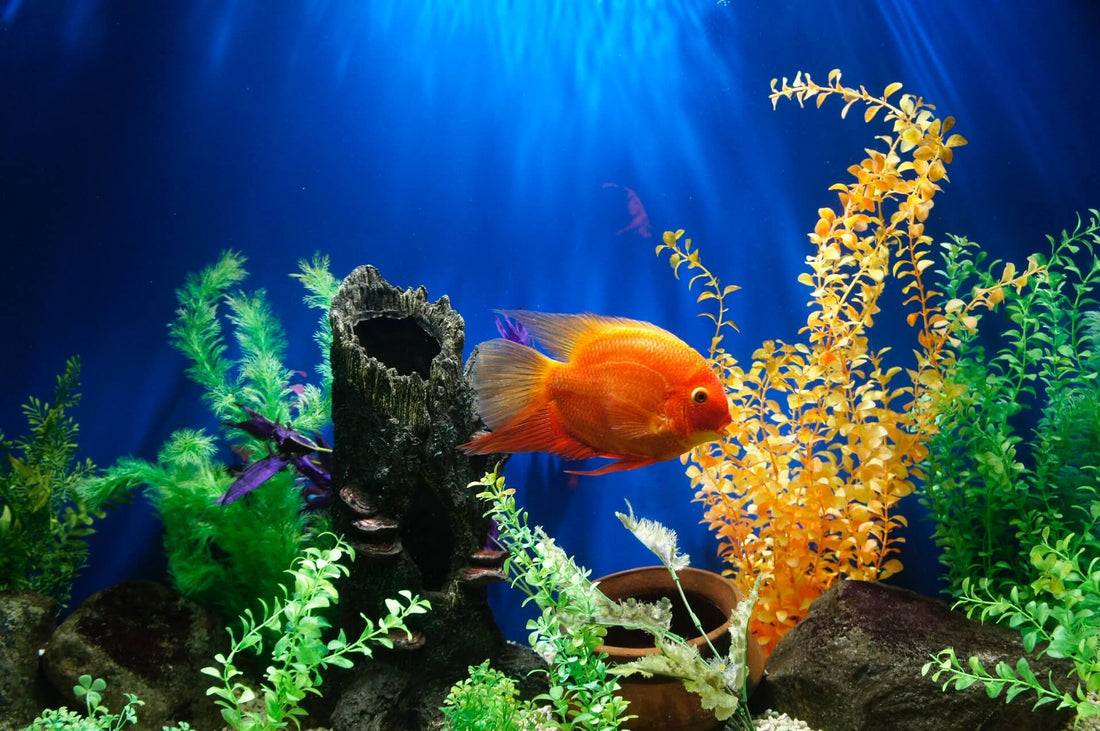Novice fish farmers are often very envious of other people's fish tanks with clear water and beautiful fish. They spend a lot of money to buy equipment, fish tanks, filters, and toss a lot of chemicals, but in the end they can't avoid fish death, turbid water quality, and can't find any reason most of the time. Many fish lovers have fallen on this road.
Why can the water quality of other people's homes be so good, and the fish are all beautiful and strong? Whether it is an ordinary goldfish or a noble arowana. In fact, as long as you master certain rules of fish farming, no matter what kind of fish, your fish tank can also achieve clear water and beautiful fish.
1. Container
First of all, you need to prepare a suitable fish tank. The larger the volume of water, the smaller the change in water quality. At the same time, the larger the surface area of the water, the higher the oxygen capacity of the water. Therefore, the small round fish tank or the narrow wall-mounted fish tank and various special-shaped fish tanks are actually not suitable for maintaining good water quality and raising fish for a long time.
What you need is a larger container as much as possible according to the species of fish you want to keep and the environment. Even if you put a few guppies on your desk, the length of the fish tank should be at least 30 cm.
For family fish farming, if conditions permit, try to choose a glass fish tank with a length of more than 40 cm, a width of more than 20 cm, and a height of at least 20 cm. For this basic tank size, you'd better only keep ovoviviparous fish or Tetra and small fish such as Tiger Fish.
If you want to raise medium-sized fish such as goldfish, blood parrot, angelfish, green terror, and giant gourami, you need a fish tank or aquarium with a height of at least 60 cm. Although it is difficult for cichlid to grow more than 20 cm in a family fish tank, considering its aggressiveness and the need for landscaping, it is also necessary to choose a fish tank over 60 cm, and the density should not be too large.
For medium and large fish such as koi, Flower horn, arowana, stingray, etc., the size of the fish tank should be larger, preferably more than 100 cm, and it is best to use an aquarium, because koi and arowana will jump out of the tank when they are startled and feel a sudden change in water quality, the lid of the aquarium can prevent the fish from jumping out of the tank.

2. Environment
Due to the limited volume of water in the fish tank, the environment in the water is easily affected by the external environment. The environment mentioned here is the external environment where the fish tank is placed. The basic elements that fish need to survive in water are oxygen capacity, water temperature, light, PH value, water hardness, ammonia nitrogen, nitrite concentration, etc., and the first three are directly affected by the external environment of the water, therefore, the location of the fish tank has a great impact on the water environment in the fish tank.
a. Oxygen capacity
The dissolved oxygen content of fresh water is generally 5-8 mg/L, which can meet the needs of most ornamental fish. The dissolved oxygen rate of the water surface of the fish tank directly depends on the ventilation of the external environment and the fluctuation of the water surface. Fish tanks that do not use oxygenation pumps are best placed in well-ventilated balconies and living rooms.
b. Water temperature
Water temperature is very important for tropical fish. Most tropical fish need to live in water of 18-28 degrees Celsius. Changes in water temperature not only affect sensitive tropical fish, but also have a huge impact on water oxygen capacity and water quality. Although the rise in water temperature reduces the dissolved oxygen rate and triggers the proliferation of harmful bacteria, tropical fish still require relatively warm and constant water temperature. Even with heating rods, large temperature fluctuations outside the fish tank can still make the heating device less efficient. Therefore, when raising tropical fish, the fish tank must be placed in an indoor environment with small temperature fluctuations, preferably with heating in winter.
c. Light
Sunlight is a love-hate thing for fish lovers, because sufficient natural light can make aquatic plants grow quickly and kill many kinds of pathogenic bacteria in the water. However, the exposure of natural light, while benefiting the aquatic plants in the aquarium, will also lead to the proliferation of algae in the aquarium. In light cases, moss, which affects viewing, will grow on the wall of the tank, and in severe cases, silk algae will erupt, which will destroy the planted scene of the tank. Aquarium fish tanks mainly for aquatic plants should not be placed on balconies or windows with strong natural light. Only special aquatic plants and germicidal lamps can be used to provide the necessary light source for aquatic plants to grow and kill harmful bacteria in the water.
For cold-water fish or large and medium-sized tropical fish raised in naked tanks, it is not necessary to add a powerful artificial light source. Appropriate natural light is necessary to maintain water quality (mainly beneficial to the growth of light and bacteria), kill germs, and maintain the color of beautiful fish. Even if moss grows on the tank wall, as long as you are diligent and often wipe with a magnetic brush, the natural light exposure is still good. In general, the advantages outweigh the disadvantages. Especially in the spring and winter seasons when the water mold is popular, the ultraviolet rays in the sunlight can kill a large number of pathogenic bacteria and prevent the occurrence of water mold and water mold mumps.

3. Water
More than 90% of fish lovers are accustomed to using tap water as water for fish breeding, and very few fish lovers use well water or purified water. No matter what kind of water it is, it cannot be directly mixed into the fish tank for raising fish, especially tap water and well water. The tap water is the rivers, lakes and groundwater treated by the water plant. Before these natural water sources reach your home, they must go through the steps of sedimentation, filtration, and disinfection in the water plant. It is the disinfection procedure that makes the tap water unsuitable for direct fish farming.
The disinfection of modern tap water mostly uses chlorine gas, which dissolves into water to generate hydrochloric acid and hypochlorous acid. The residual hypochlorous acid in the tap water will make the fish feel uncomfortable, and the hypochlorous acid entering the gills will also cause congestion in the gills and affect the fish's breathing. Aquatic plants are also sensitive to hypochlorous acid in tap water. The accumulation of a large amount of chlorine in aquatic plants will affect the absorption of iron, manganese, selenium and other elements by aquatic plants, which is not conducive to the growth of aquatic plants.
Before using tap water to raise fish, the water must be illuminated and fully contacted with the air. Hypochlorous acid is easy to volatilize when exposed to light. After a large amount of water and air contact, it not only increases the dissolved oxygen, but also accelerates the fluctuation of the water, so that the hypochlorous acid volatilizes into the air faster. In addition, these measures can warm the cooler tap water to the same temperature as the water in the tank, reducing fish discomfort and white spot disease outbreaks caused by changes in water temperature.
Well water and purified water do not contain hypochlorous acid, but they should be exposed to light and air before use, and at least the water temperature should be the same as the water in the fish tank. Water comes into contact with air, in the case of light, it takes 24 hours, in the case of no light, it takes 48 hours.
4. Filter
There are various ways of aquarium filtration, including upper filter, side filter, bottom filter, canister filter, filter bucket, sponge filter, hang on back filter, internal filter, water and air convection filter and so on. The most important function of the filtration system is to reduce the content of ammonia nitrogen and nitrite in the water, because both ammonia and nitrite are toxic substances, and neither fish nor aquatic plants can survive in water with high concentrations of ammonia and nitrite.
A good filtration system has dual functions of physical filtration and biochemical filtration. Physical filtration is carried out through filter sponge, which mainly blocks organic and inorganic insoluble impurities in the water, so that the water body can achieve basic permeability, which is beneficial to ornamental fish and aquatic plants.
Biochemical filtration is realized through biochemical cotton, bioball, bacterial house, ceramic ring, magic carpet and other filter materials. These filter media have a common feature: within a limited volume, they have a huge physical surface area to provide an environment for nitrifying bacteria to grow. In order to make biochemical filtration fully and thoroughly remove ammonia nitrogen and nitrite in water, let your filter have as many biochemical filter materials as possible, and arrange the discharge position of biochemical filter materials reasonably and scientifically.
A filter system can be reasonably configured according to the size of your fish tank and the type of ornamental fish. A fish tank of about 30 cm can be equipped a hang on back filter and gravel. 30cm to 60cm fish tank can be equipped with a set of top filter and trickle filter. The upper filter is the simplest form of filtration, as the size of the fish tank increases, the volume and number of layers of the upper filter should also increase.
However, an oversized upper filtration system is not only unsafe, but also causes the water temperature to be lost too quickly. Therefore, for fish tank filtration systems above 60 cm, back filter and bottom filter are preferred, and canister filter is also a good choice. If the back filter or bottom filter cannot be used, a set of upper filter and water and air convection filter can be adopted to improve the efficiency of the whole set of filtration.
As for the addition of activated carbon, ammonia-absorbing zeolite, volcanic stone, water softening resin, coral sand and other filter media to the filtration system, it can also achieve different effects of regulating water quality, but compared with basic biochemical filtration, these are the icing on the cake. If the biochemical filtration is good enough, these filter media can be completely omitted. The filter system is the core of the fish tank ecology. It is necessary to match the fish tank with a good filter system as much as possible.

According to the above method, you can also have an ecological fish tank with clear water and beautiful fish. Do you have any tips for raising fish? Welcome to share with us in the comment section.

